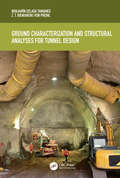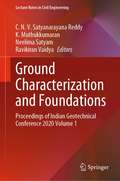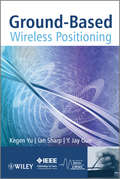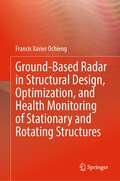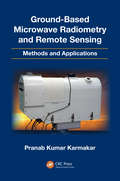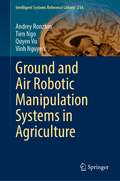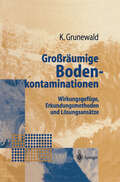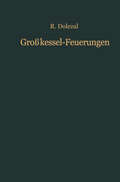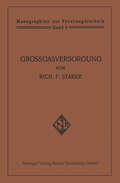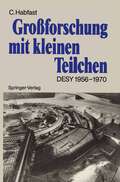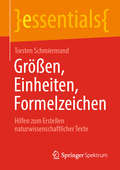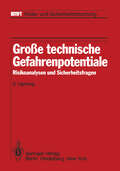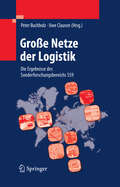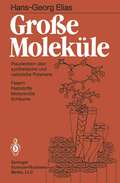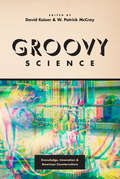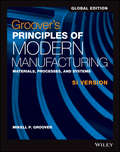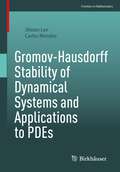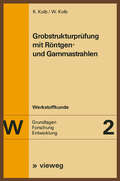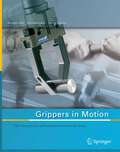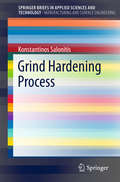- Table View
- List View
Ground Characterization and Structural Analyses for Tunnel Design
by Benjamín Celada Z.T. BieniawskiThis practical and design-oriented book focuses on ground characterization and structural calculation, as part of the active structural design methodology. With a focus on rock tunnelling it offers a comprehensive rather than a topic-based perspective, deriving sound tunnel design criteria and methods from basic principles. Ground characterization includes excavations, site investigation, and in situ stress determination, culminating in geotechnical classifications. The book then deals with various construction methods and their appropriate calculations, which range from constitutive models for the stress-strain behaviour of an excavation and tunnel support elements to a full stress–strain analysis methodology. The heavily practical approach of the book draws on the authors’ twenty years of tunnelling experience in Spain and South America. It will help any young or established professional who wants to develop a career in the underground field across both civil engineering and geology. As it incorporates the very fundamentals of tunneling design, it can be used as a support for tunneling courses or as a textbook for master’s and PhD courses. Benjamín Celada was Chief Tunnel Engineer at Hunosa and Potasas de Navarra S.A. before founding Geocontrol S.A. He has also worked for twenty years as Professor of Underground Works at the Polytechnic Mining University in Madrid, Spain. Z. T. Bieniawski directed the Rock Mechanics Department of the Council for Scientific and Industrial Research in Pretoria, then taught at the Pennsylvania State University for twenty years.
Ground Characterization and Foundations: Proceedings of Indian Geotechnical Conference 2020 Volume 1 (Lecture Notes in Civil Engineering #167)
by C. N. V. Satyanarayana Reddy K. Muthukkumaran Neelima Satyam Ravikiran VaidyaThis book comprises the select proceedings of the Indian Geotechnical Conference (IGC) 2020. The contents focus on recent developments in geotechnical engineering for a sustainable tomorrow. The book covers the topics related to traditional and latest methods in characterisation of ground at construction sites, recent technological developments/ advances in design of shallow and deep foundations in different subsoil conditions.
Ground-Based Wireless Positioning (Wiley - IEEE #5)
by Kegen Yu Ian Sharp Y Jay GuoGround Based Wireless Positioning provides an in-depth treatment of non-GPS based wireless positioning techniques, with a balance between theory and engineering practice. The book presents the architecture, design and testing of a variety of wireless positioning systems based on the time-of-arrival, signal strength, and angle-of-arrival measurements. These techniques are essential for developing accurate wireless positioning systems which can operate reliably in both indoor and outdoor environments where the Global Positioning System (GPS) proves to be inadequate. The book covers a wide range of issues including radio propagation, parameter identification, statistical signal processing, optimization, and localization in large and multi-hop networks. A comprehensive study on the state-of-the-art techniques and methodologies in wireless positioning and tracking is provided, including anchor-based and anchor-free localisation in wireless sensor networks (WSN). The authors address real world issues such as multipath, non-line-of-sight (NLOS) propagation, accuracy limitations and measurement errors. Presenting the latest advances in the field, Ground Based Wireless Positioning is one of the first books to cover non-GPS based technologies for wireless positioning. It serves as an indispensable reference for researchers and engineers specialising in the fields of localization and tracking, and wireless sensor networks. Provides a comprehensive treatment of methodologies and algorithms for positioning and tracking Includes practical issues and case studies in designing real wireless positioning systems Explains non-line-of-sight (NLOS) radio propagation and NLOS mitigation techniques Balances solid theory with engineering practice of non-GPS wireless systems
Ground-Based Radar in Structural Design, Optimization, and Health Monitoring of Stationary and Rotating Structures
by Francis Xavier OchiengThis book provides a practical application for using ground-based radar (GBR) as a remote (non-contact) sensor for structural health monitoring (SHM) in the development of sustainable and robust stationary and rotating structures, such as beam-like bridges, towers, wind turbines, and hydropower turbines. It integrates cutting-edge research into an easy-to-understand approach for non-radar and monitoring specialists, building on the methods and theory of working with radar systems, SHM frameworks, GBR signal processing, and validation techniques. All aspects of in-field monitoring and use during the design and testing of structures are covered, including data acquisition and processing, damage detection techniques, and damage prognostic techniques. The book is a hands-on reference that provides critical information on GBR for practitioners, university instructors, and students involved in structural design, optimization, and health monitoring of stationary and rotating structures.
Ground-Based Microwave Radiometry and Remote Sensing: Methods and Applications
by Pranab Kumar KarmakarThe ability to effectively monitor the atmosphere on a continuous basis requires remote sensing in microwave. Written for physicists and engineers working in the area of microwave sensing of the atmosphere, Ground-Based Microwave Radiometry and Remote Sensing: Methods and Applications is completely devoted to ground-based remote sensing. This text
Ground and Air Robotic Manipulation Systems in Agriculture (Intelligent Systems Reference Library #214)
by Andrey Ronzhin Tien Ngo Quyen Vu Vinh NguyenProblems of joint application of heterogeneous ground and air robotic means while performing the agricultural technological tasks that require physical interaction with agricultural products and the environment are discussed in the book. Proposed solutions for the exchange of energy and physical resources of unmanned aerial vehicles on ground service platforms, automation of the process of collecting agricultural products and ensuring the stability of the air manipulation system at physical interaction with a ground object are important for the transport and agricultural industry robotization.The book addresses the researchers investigating interdisciplinary issues of agricultural production robotization, problems of information, physical and energy interaction of ground and air robots; recommended to postgraduates and students studying "Mechatronics and robotics" and "Technologies, mechanization and power equipment in agriculture, forestry and fisheries."
Großräumige Bodenkontaminationen: Wirkungsgefüge, Erkundungsmethoden und Lösungsansätze
by Karsten GrunewaldGroßgasversorgung: Technik und Wirtschaft der Fernleitung der Gase unter hohem Druck als Grundlage für eine Großgasverwertung der Kohlenenergie in Deutschland mit zentraler Gaserzeugung in den Steinkohlen- und Braunkohlen-Revieren (Monographien zur Feuerungstechnik #6)
by Rich. F. StarkeDieser Buchtitel ist Teil des Digitalisierungsprojekts Springer Book Archives mit Publikationen, die seit den Anfängen des Verlags von 1842 erschienen sind. Der Verlag stellt mit diesem Archiv Quellen für die historische wie auch die disziplingeschichtliche Forschung zur Verfügung, die jeweils im historischen Kontext betrachtet werden müssen. Dieser Titel erschien in der Zeit vor 1945 und wird daher in seiner zeittypischen politisch-ideologischen Ausrichtung vom Verlag nicht beworben.
Großforschung mit kleinen Teilchen: Das Deutsche Elektronen-Synchrotron DESY 1956–1970
by Claus HabfastDas Deutsche Elektronensynchrotron (DESY) in Hamburg ist international eines der erfolgreichsten Laboratorien für Teilchenphysik. Es gehört zu den in der Öffentlichkeit bekanntesten Großforschungseinrichtungen der Bundesrepublik. Claus Habfast, selbst ein erfahrener Teilchenphysiker, beschreibt hier im Rahmen einer großangelegten Studie zur Geschichte der Deutschen Großforschung die Ursprünge von DESY im Jahre 1956 bis zu seiner endgültigen internationalen Etablierung in den frühen 70er Jahren. Dem Autor standen für seine Vorarbeiten sowohl das Archiv der Forschungseinrichtung als auch staatliche Archive zur Verfügung. Darüber hinaus wurden Laborberichte und Fachliteratur, sowie private Quellen, herangezogen, so daß eine detaillierte und facettenreiche Beschreibung entstanden ist. Für den Historiker eröffnet das Werk umfangreiches, bisher unerschlossenes Quellenmaterial. Das Buch richtet sich an alle, die an der Teilchenphysik und dem Entstehen des Großlabors DESY, sowie an der Wissenschaftspolitik in der Bundesrepublik Deutschland, interessiert sind.
Größen, Einheiten, Formelzeichen: Hilfen zum Erstellen naturwissenschaftlicher Texte (essentials)
by Torsten SchmiermundSie müssen einen naturwissenschaftlich-technischen Aufsatz schreiben und stehen nun vor dem Problem, ihre wenigen Formeln und Gleichungen korrekt darstellen zu wollen? Sie besitzen bereits Bücher zum Thema „Schreiben einer wissenschaftlichen Arbeit“, möchten zusätzlich aber erfahren, wie Sie bestimmte Sonderzeichen erzeugen können? Sie kennen sich in der Materie schon ganz gut aus, möchten aber regelkonform schreiben? Dieses essential liefert Ihnen Antworten in komprimierter Form. Neben allgemeinen Tipps erhalten Sie auch solche für das Arbeiten mit MS Word und darüber hinaus Informationen zum Umgang mit MS Excel, MS Powerpoint, OpenOffice und LibreOffice.
Große technische Gefahrenpotentiale: Risikoanalysen und Sicherheitsfragen (BMFT - Risiko- und Sicherheitsforschung)
by S. HartwigGroße Netze der Logistik: Die Ergebnisse des Sonderforschungsbereichs 559
by Peter Buchholz Uwe ClausenLogistik spielt eine entscheidende Rolle für unsere Volkswirtschaft. Logistik-Netze werden jedoch aufgrund steigender Anforderungen immer größer, komplexer und damit schwerer zu planen und zu beherrschen. Dafür sind Methoden der Analyse, Planung und Optimierung erforderlich. In diesem Band werden neue Methoden zur Planung und zum Betrieb großer Netze dargestellt, die Wissenschaftler aus den Bereichen Logistik, Informatik, Betriebswirtschaftslehre, Statistik und Soziologie gemeinsam entwickelt und auf praxisnahe Beispiele angewendet haben.
Große Moleküle: Plaudereien über synthetische und natürliche Polymere
by Hans-Georg EliasOhne Makromoleküle gibt es kein Leben. Menschen, Tiere und Pflanzen wären ohne Gerüst-, Vorrats- und Transport stoffe aus Makromolekülen nicht existent; ohne die makromo lekularen DNA und RNA könnte sich kein Leben fortpflanzen. Ohne Makromoleküle würden wir uns nur von Wasser, Zuk kern, Fetten, Vitaminen und Salzen ernähren, müßten aber auf Fleisch, Eier, Getreide, Gemüse und Früchte verzichten. Wir könnten nicht in Häusern wohnen, denn Holz und viele Gesteine sind aus Makromolekülen aufgebaut. Ohne Makro moleküle auch keine Kleidung: alle Fasern bestehen aus Makromolekülen. Kein jetziges Auto könnte fahren, da alle Reifen makromolekular sind. Ohne Makromoleküle keine fotografischen Filme, keine Elektronik ... Wenn Makromoleküle so wichtig sind, warum ist dann ihre Rolle so wenig bekannt und warum werden sie im Schulunter richt so wenig erwähnt? Wie häufig in der menschlichen Geschichte, spielt Tradition eine Rolle und die Wissenschaft macht da keine Ausnahme. Die Chemie etablierte sich als Chemie niedermolekularer Substanzen, weil diese am einfach sten zu untersuchen und chemisch umzuwandeln waren. Längst hatte die Chemie ein wunderbares Gedankengebäude errich tet, als die Idee von riesigen Molekülen, Makromolekülen, aufkam. In diesem Gebäude gab es einfach keinen Platz mehr für die Neuankömmlinge. Noch heute kann man Chemie stu dieren, ohne von Makromolekülen zu hören.
Groovy Science: Knowledge, Innovation, and American Counterculture
by David Kaiser and W. Patrick McCray W. Patrick McCrayIn his 1969 book The Making of a Counterculture, Theodore Roszak described the youth of the late 1960s as fleeing science “as if from a place inhabited by plague,” and even seeking “subversion of the scientific worldview” itself. Roszak’s view has come to be our own: when we think of the youth movement of the 1960s and early 1970s, we think of a movement that was explicitly anti-scientific in its embrace of alternative spiritualities and communal living. Such a view is far too simple, ignoring the diverse ways in which the era’s countercultures expressed enthusiasm for and involved themselves in science—of a certain type. Rejecting hulking, militarized technical projects like Cold War missiles and mainframes, Boomers and hippies sought a science that was both small-scale and big-picture, as exemplified by the annual workshops on quantum physics at the Esalen Institute in Big Sur, or Timothy Leary’s championing of space exploration as the ultimate “high.” Groovy Science explores the experimentation and eclecticism that marked countercultural science and technology during one of the most colorful periods of American history.
Groovy Science: Knowledge, Innovation, and American Counterculture
by David Kaiser and W. Patrick McCray W. Patrick McCrayIn his 1969 book The Making of a Counterculture, Theodore Roszak described the youth of the late 1960s as fleeing science “as if from a place inhabited by plague,” and even seeking “subversion of the scientific worldview” itself. Roszak’s view has come to be our own: when we think of the youth movement of the 1960s and early 1970s, we think of a movement that was explicitly anti-scientific in its embrace of alternative spiritualities and communal living. Such a view is far too simple, ignoring the diverse ways in which the era’s countercultures expressed enthusiasm for and involved themselves in science—of a certain type. Rejecting hulking, militarized technical projects like Cold War missiles and mainframes, Boomers and hippies sought a science that was both small-scale and big-picture, as exemplified by the annual workshops on quantum physics at the Esalen Institute in Big Sur, or Timothy Leary’s championing of space exploration as the ultimate “high.” Groovy Science explores the experimentation and eclecticism that marked countercultural science and technology during one of the most colorful periods of American history.
Groovy Science: Knowledge, Innovation, and American Counterculture
by David Kaiser and W. Patrick McCray W. Patrick McCrayIn his 1969 book The Making of a Counterculture, Theodore Roszak described the youth of the late 1960s as fleeing science “as if from a place inhabited by plague,” and even seeking “subversion of the scientific worldview” itself. Roszak’s view has come to be our own: when we think of the youth movement of the 1960s and early 1970s, we think of a movement that was explicitly anti-scientific in its embrace of alternative spiritualities and communal living. Such a view is far too simple, ignoring the diverse ways in which the era’s countercultures expressed enthusiasm for and involved themselves in science—of a certain type. Rejecting hulking, militarized technical projects like Cold War missiles and mainframes, Boomers and hippies sought a science that was both small-scale and big-picture, as exemplified by the annual workshops on quantum physics at the Esalen Institute in Big Sur, or Timothy Leary’s championing of space exploration as the ultimate “high.” Groovy Science explores the experimentation and eclecticism that marked countercultural science and technology during one of the most colorful periods of American history.
Groovy Science: Knowledge, Innovation, and American Counterculture
by David Kaiser Patrick McCrayIn his 1969 book The Making of a Counterculture, Theodore Roszak described the youth of the late 1960s as fleeing science “as if from a place inhabited by plague,” and even seeking “subversion of the scientific worldview” itself. Roszak’s view has come to be our own: when we think of the youth movement of the 1960s and early 1970s, we think of a movement that was explicitly anti-scientific in its embrace of alternative spiritualities and communal living. Such a view is far too simple, ignoring the diverse ways in which the era’s countercultures expressed enthusiasm for and involved themselves in science—of a certain type. Rejecting hulking, militarized technical projects like Cold War missiles and mainframes, Boomers and hippies sought a science that was both small-scale and big-picture, as exemplified by the annual workshops on quantum physics at the Esalen Institute in Big Sur, or Timothy Leary’s championing of space exploration as the ultimate “high.” Groovy Science explores the experimentation and eclecticism that marked countercultural science and technology during one of the most colorful periods of American history.
Groovy Science: Knowledge, Innovation, and American Counterculture
by David Kaiser W. Patrick McCrayIn his 1969 book The Making of a Counterculture, Theodore Roszak described the youth of the late 1960s as fleeing science “as if from a place inhabited by plague,” and even seeking “subversion of the scientific worldview” itself. Roszak’s view has come to be our own: when we think of the youth movement of the 1960s and early 1970s, we think of a movement that was explicitly anti-scientific in its embrace of alternative spiritualities and communal living. Such a view is far too simple, ignoring the diverse ways in which the era’s countercultures expressed enthusiasm for and involved themselves in science—of a certain type. Rejecting hulking, militarized technical projects like Cold War missiles and mainframes, Boomers and hippies sought a science that was both small-scale and big-picture, as exemplified by the annual workshops on quantum physics at the Esalen Institute in Big Sur, or Timothy Leary’s championing of space exploration as the ultimate “high.” Groovy Science explores the experimentation and eclecticism that marked countercultural science and technology during one of the most colorful periods of American history.
Groovy Science: Knowledge, Innovation, and American Counterculture
by David Kaiser W. Patrick McCrayIn his 1969 book The Making of a Counterculture, Theodore Roszak described the youth of the late 1960s as fleeing science “as if from a place inhabited by plague,” and even seeking “subversion of the scientific worldview” itself. Roszak’s view has come to be our own: when we think of the youth movement of the 1960s and early 1970s, we think of a movement that was explicitly anti-scientific in its embrace of alternative spiritualities and communal living. Such a view is far too simple, ignoring the diverse ways in which the era’s countercultures expressed enthusiasm for and involved themselves in science—of a certain type. Rejecting hulking, militarized technical projects like Cold War missiles and mainframes, Boomers and hippies sought a science that was both small-scale and big-picture, as exemplified by the annual workshops on quantum physics at the Esalen Institute in Big Sur, or Timothy Leary’s championing of space exploration as the ultimate “high.” Groovy Science explores the experimentation and eclecticism that marked countercultural science and technology during one of the most colorful periods of American history.
Groover's Principles of Modern Manufacturing: Materials, Processes, and Systems
by Mikell P. GrooverGroover's Principles of Modern Manufacturing is designed for a first course or two-course sequence in Manufacturing at the junior level in Mechanical, Industrial, and Manufacturing Engineering curricula. As in preceding editions, the author's objective is to provide a treatment of manufacturing that is modern and quantitative. The book's modern approach is based on balanced coverage of the basic engineering materials, the inclusion of recently developed manufacturing processes and comprehensive coverage of electronics manufacturing technologies. The quantitative focus of the text is displayed in its emphasis on manufacturing science and its greater use of mathematical models and quantitative end-of-chapter problems.
Gromov-Hausdorff Stability of Dynamical Systems and Applications to PDEs (Frontiers in Mathematics)
by Jihoon Lee Carlos MoralesThis monograph presents new insights into the perturbation theory of dynamical systems based on the Gromov-Hausdorff distance. In the first part, the authors introduce the notion of Gromov-Hausdorff distance between compact metric spaces, along with the corresponding distance for continuous maps, flows, and group actions on these spaces. They also focus on the stability of certain dynamical objects like shifts, global attractors, and inertial manifolds. Applications to dissipative PDEs, such as the reaction-diffusion and Chafee-Infante equations, are explored in the second part. This text will be of interest to graduates students and researchers working in the areas of topological dynamics and PDEs.
Grippers in Motion: The Fascination of Automated Handling Tasks
by Andreas Wolf Ralf Steinmann Henrik SchunkGrippers in Motion provides a comprehensive, practice-oriented guide to the fascinating details of automation processes involving gripping and manipulation. This intriguing and colorful book leads the reader from the history of automation and robotics to the fundamentals of the gripping process as well as the interaction of the gripping process with individual workpieces. Boundary conditions and initial situation of the gripping process are defined, and how subsequent motion follows gripping is shown. The implementation of these motion processes, from simple linear motions to the kinematics of multiple axes, is illustrated in a practical way. This practical introduction motivates students and even professionals to learn more about the world of robotic grippers. Grippers in Motion includes a spectrum of real-world applications demonstrating the possibilities and varieties of automation in practice.
Grind Hardening Process (SpringerBriefs in Applied Sciences and Technology)
by Konstantinos SalonitisThis book presents the grind-hardening process and the main studies published since it was introduced in 1990s. The modelling of the various aspects of the process, such as the process forces, temperature profile developed, hardness profiles, residual stresses etc. are described in detail. The book is of interest to the research community working with mathematical modeling and optimization of manufacturing processes.
